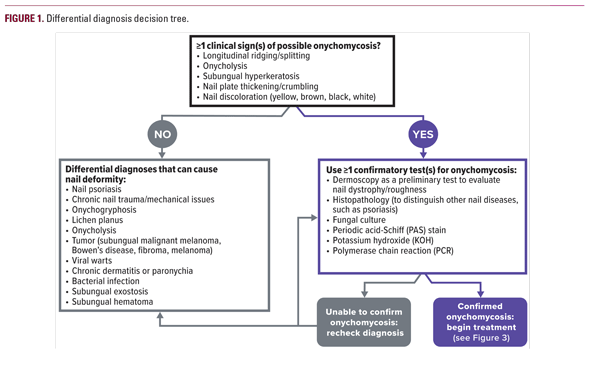
contraindications to oral medications.12,14,15 Combination treatments with an oral and topical therapy were recommended if the expected topical monotherapy response would be poor,12 or if there was >50%–60% nail involvement, matrix involvement, or >3 nails involved.1,14,15 Non-pharmaceutical treatments such as debridement alone, lasers, or photodynamic therapy were not recommended due to lack of efficacy and sparse data from clinical trials supporting their use.12,14
National guidelines and consensus documents on onychomycosis diagnosis and treatment were last published in 2014 (British12) and 2015 (Canadian1)—around the time that both topical efinaconazole and tavaborole were first approved in the US in 2014. Since then, more data have become available for topical tavaborole and efinaconazole and both have received US approvals for use in pediatric patients (aged ≥6 years).17,18 In addition, terbinafine resistance may be a growing issue.10,19 As such, updated medical guidance is needed.
This document aims to provide recommendations for the diagnosis and therapeutic treatment of toenail onychomycosis following a roundtable discussion with the authors on March 15, 2021. Included in this article are a decision tree for choosing appropriate medications based on disease severity and patient characteristics, as well as a handout intended for patients on best practices to mitigate disease recurrence.
Diagnosis, Testing, and Clinical Presentation
When diagnosing onychomycosis, careful assessment and testing must be performed as nail dystrophy can be induced by over 20 disorders15 and there are many common conditions that can mimic onychomycosis.20 Nail dystrophies due to nail psoriasis, chronic trauma, mechanical issues (toe overlaps, etc.), onychogryphosis, lichen planus, or other diseases that have a similar clinical appearance to onychomycosis should be ruled out (see Figure 1).12,13,20
In addition to identifying clinical signs, laboratory testing should be performed to identify the infecting organism and exclude any non-fungal conditions.1,12 Preferred confirmatory testing methods may differ between dermatologists and podiatrists, but common options include clinical diagnosis in conjunction with one or more of the following: KOH with microscopy on nail subungual debris; fungal culture on subungual debris; and histopathology on nail clippings with PAS or Gomori methenamine silver staining. When obtaining subungual debris for KOH or culture, the most proximal involvement should be sampled via 2 mm curette or nail elevator; additionally, an attached nail bed is optimal for PAS samples. Dermoscopy can also be used to help confirm the diagnosis of onychomycosis and rule out other nail diseases and biomechanical issues. In addition, PCR may be performed for identification of the infecting organism. PCR may be costly and has high sensitivity,






